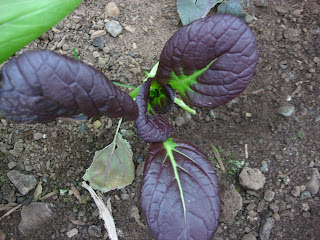 By Robin Sturley
Edible Earth Seeds
www.edibleearthseeds.com
By Robin Sturley
Edible Earth Seeds
www.edibleearthseeds.com
It’s late summer and the garden is looking full and abundant. Tucked behind the leafy tomatoes and the lanky borage you may be discovering that some of your vegetables took advantage of your busy schedule to push on through to the final phase of their lives – they’ve gone to seed. Are all of these finds worth keeping? Well, that all depends. Now and then a fortuitous mistake can lead to a bountiful crop of seeds. It must be said however that not all of these lucky finds are worth harvesting.
Whenever I answer questions about seed saving, I try to communicate two seemingly contradictory messages. #1 Seed saving is simple. #2 Seed saving is not as simple as we might like to think. Why the mixed messages? On the one hand I believe we need as many seed savers as possible, and the plants do most of the work by far, so in that sense it really is easy! I certainly do not want to discourage anyone from saving seed. It is necessary, and all-round a good thing to do. On the other hand, seed saving done well requires some ground rules, and real food security requires seed saving done well. So in this sense it is not quite as simple as one might hope, and is something that should be given the attention it deserves.
So, in a nutshell, how is seed saving easy?
The plants do most of the work.
Let’s face it: creating a perfect package of nutrients and genetic information to carry on a unique life form is something we still don’t quite have a handle on. Plants on the other hand have it down pat. Take care of the soil, and it will take care of the plants. Take care of the plants and they will take care of the seed.
A lot of it involves not doing things.
In seed saving you will find yourself not doing things. For example, not harvesting so regularly, so that more fruit will ripen seed. Not weeding and watering so carefully, so that you can use these pressures to put your plants to the test and select for the hardiest individuals.
Sometimes, all you need are a few plants and some patience.
For plants that self-pollinate, like beans, peas, tomatoes and lettuce, it is often sufficient to let a few plants do their things, complete their life cycle, and voila! You will have an abundance of beautiful seed, perfectly adapted to the unique conditions of your garden.
How is seed saving not that easy?
Sometimes, you need more than just a few plants and some patience.
Yes, it must be said, when it comes to the cross-pollinating plants, a few unruly individuals left to their own devices will not yield great seed. Sometimes, it won’t even yield good seed, and sometimes none at all. Understanding the difference between self-pollinating and cross-pollinating plants is critical to good seed saving. While self-pollinating plants do just that, and so do not require a large population to stay vigorous, cross-pollinating plants must be given the opportunity to mingle with at least 40 or so of their own kind in order to produce vigorous, abundant seed.
Seeds and water don’t always mix.
Although our hot, dry summers are perfect for seed growing, our unpredictable and sometimes rainy late summers and falls can put a good seed crop out of reach. I personally just experienced the loss of an entire lettuce seed crop 3 days away from harvest, due to an unexpected overnight rain. Once dry seed has been saturated with water, it is not worth saving.
The birds and the bees will do as they please.
Reproduction is probably the strongest biological impulse in all of nature, and our vegetables are not exception. It is very important to find out which veggies will cross-pollinate with one another, and which ones won’t, if you want to get ‘true to type’ seed. That is, is you’d like your kale to stay kale and your broccoli to stay broccoli, you’ll need to know that you can’t grow them together and still save seed. There are many other not-so-obvious examples of free-lovin’ vegetables, so good reference material is essential to good seed saving.
Happy seed saving!



































